
Due to the refraining from going out and restrictions on going out due to the corona crisis, the growth rate of the EC channel, which has a non-contact nature, accelerated, and the BtoC-EC market size in the product sales field grew significantly to 12.2 trillion yen, a year-on-year growth rate of 22%. (Source: Ministry of Economy, Trade and Industry HP). However, even though the frequency of digital use in people's lives is increasing at a faster pace than ever before, the EC rate is still 8%, and sales composition ratios other than EC channels are still high. In this article, we will consider how to design "touchpoints with customers" and what kind of purchasing experience should be provided in the post-corona era.
Since May 2020, when Japan first declared a state of emergency due to the corona crisis, the growth rate of the contactless e-commerce channel has accelerated. In 2020, the EC growth rate in the product sales field will reach 22 %, and the market size will reach 12.2 trillion yen. Opportunities to use digital technology in people's lives have steadily increased.
However, although the growth rate is certainly high, the EC rate in the product sales field in 2020 is only 8 %. The growth in 2020 only increased the overall EC rate by 1.32 points. We would like to ask Mr. Syusuke Komatsu, the representative of Colabofact, about the situation where shopping at physical stores is still the mainstream. Mr. Komatsu has experience in digital marketing strategy, execution, analysis, business strategy, P/L management, demand forecasting, and product planning as a buyer at a digital marketing support company and Amazon Japan.

(From left: Macnica Ota, Colabofact Komatsu)
In June 2021, there is a questionnaire survey on life in general in the corona misfortune. According to this, some people answered that shopping at shopping malls and department stores can be replaced by other methods, but more people answered that they cannot be replaced.
The reason is that it is not possible to "enjoy with the five senses" or "enjoy extraordinary sensations". Based on these results, "When launching a new e-commerce business in the future, we cannot ignore the customer experience at this physical store, and we cannot satisfy customers by formulating a strategy that separates online and physical stores. You can't. It's important to take a cross-cutting view of the online and the real world," says Mr. Komatsu.
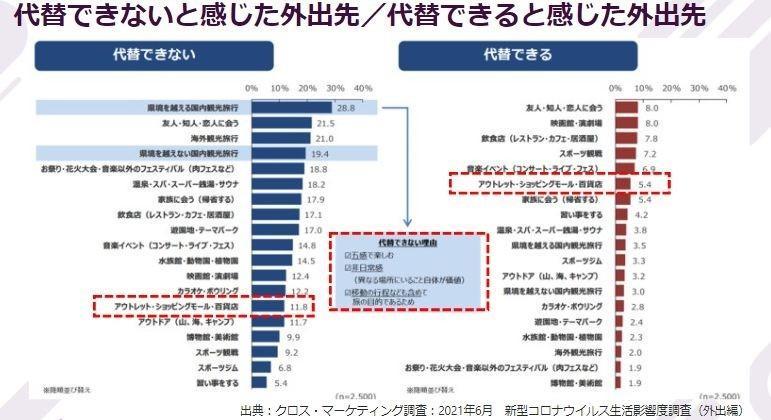
Mr. Komatsu's "strategy that crosses online and real" points out the same point in his book "Kotler's Retail4.0" by Philip Kotler, a prominent American business scholar. "E-commerce giants such as Amazon and Alibaba have decided to open physical stores."
Improving the purchasing experience at real stores has a major impact on the growth of e-commerce sites
The purpose of the electronic trading giant to open physical stores is to explore customer preferences from the behavior of customers at physical stores. Amazon is developing an unmanned convenience store "Amazon Go", but Mr. Komatsu, who experienced shopping at Amazon Go, which opened in San Francisco, recalls that it was an extraordinary experience.
"Even if it's not an unmanned convenience store, even in the Japanese retail industry, various data collection and collaboration with e-commerce sites are being planned for real stores." (Mr. Komatsu)
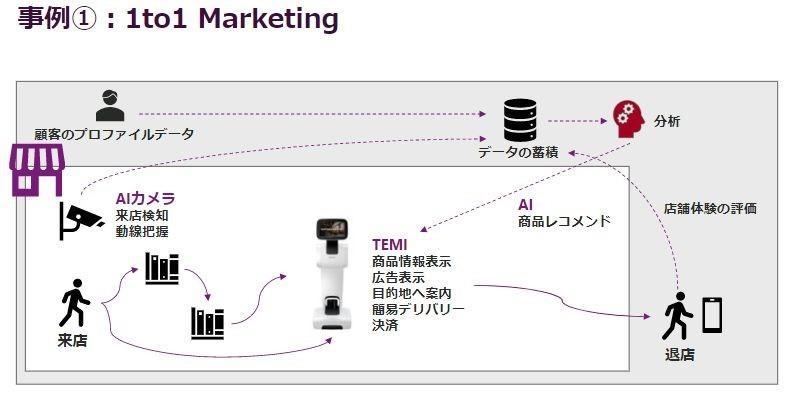
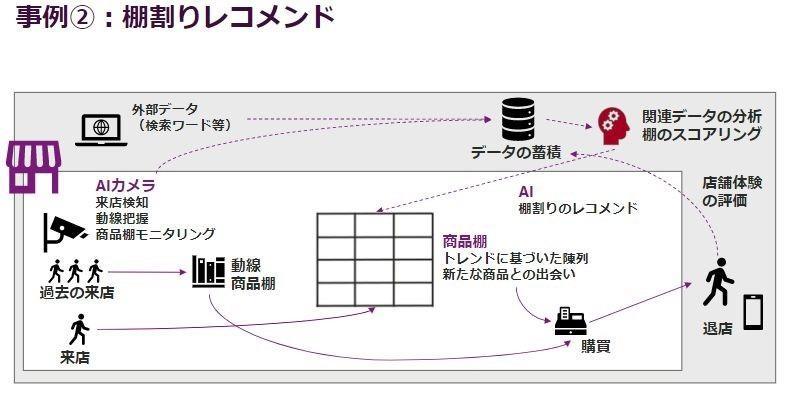
Macnica provides solutions for digitizing physical stores. We will install multiple AI cameras and convert the purchasing behavior of customers whose profiles have been obtained in advance into data. In addition, a communication robot managed by an AI system called TEMI will be placed inside the store to recommend products, respond to inquiries, and handle payments. For customers who have a profile, we analyze past data and provide them with personalized information to provide them with a new experience. Furthermore, after customers leave the store, we ask them to rate their experience in the store, and we accumulate that data.
Using the same mechanism, it is also possible to automatically recommend the planogram method to the user. It is also possible to digitize the movements of customers in the store, generate scores for each planogram, and utilize them in the actual display of products. This allows many customers to encounter new products. This method can be said to be a way to increase the purchase intention of many customers instead of customizing for each customer.
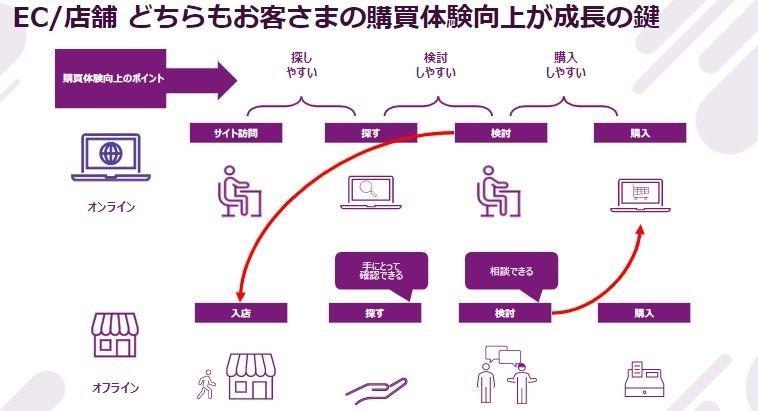
We believe that improving the purchasing experience at physical stores in this way will have a major impact on the growth of e-commerce sites.
Mr. Komatsu points out, "What I always kept in mind when operating an e-commerce site was how to make products 'easy to find,' 'easy to consider,' and 'easy to buy.'" Real stores have the advantage of being able to pick up products and examine them. When considering further, it is also important to decide while talking with the person in charge of the store. He continues that by further enhancing the unique advantages of physical stores, there is a possibility that the number of cases that ultimately lead to purchases on EC sites will increase.
Of course, there are various obstacles such as personal information issues in converting the movements of customers whose profiles are acquired in real stores into data and having customers themselves evaluate their experiences. In order for the customer to provide important information and make an active evaluation, there must be merits that are reasonably convincing. How to provide such benefits will be an issue that many users will be working on in the future.
Sophistication of "product management" rather than product information management is the key to the new era
It seems that consumers are now taking the lead in adopting the idea and behavior of ``crossing the online and real world''. After searching for products on the EC site with a smartphone or other device and obtaining general information, you can visit the store and touch the actual product to consider and purchase. Conversely, there may be a pattern of discovering a product at a real store and purchasing it on an EC site.
Here, Mr. Komatsu talked about his personal buying experience. He was looking for a rug for his living room, and was looking for rugs on an e-commerce site. The texture of the rug is an important selection point. So, I decided to go to a physical store operated by the EC site and actually touch it and check it out before buying it.
"I found a very useful function on this site, and since then, I've always used this function. It's a function that shows a list of stores that carry that product," says Mr. Komatsu. It's a casual feature, but if you don't have this, you have to call each time to inquire or go directly to a nearby store. While doing such a thing, you may fail to purchase it and leave it as it is. But since I've only been looking for it on EC sites, at that stage I'm pretty determined to buy it. If I can find a store that definitely has stock, I'm ready to buy. "Actually, I went to the store and bought it," said Mr. Komatsu.
Here, Mr. Komatsu points out the importance and difficulty of managing inventory information. Information about which store to go to for a particular product is important information that greatly influences purchases, and this information itself is nothing new or eccentric. However, in order to always present this information to customers as the latest information, major retailers must constantly manage individual data for hundreds of thousands to millions of products and be able to instantly present them on the site. it won't work. It takes a lot of effort to build and operate such a system.
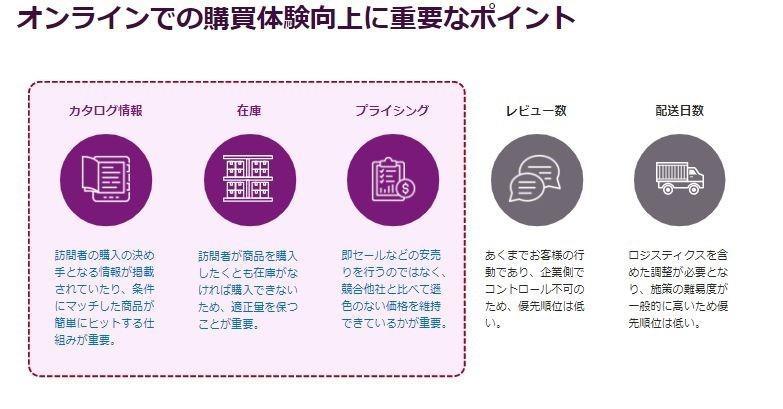
We believe that there are three important points to improve the online purchasing experience: enrichment of product catalog information, optimization of inventory, and appropriate pricing.
It is important for product catalog information to include information that will be the decisive factor in a visitor's purchase, and to make it easy to find products that match the conditions. Maintaining an appropriate amount of inventory is important because even if a visitor wants to purchase a product, it cannot be purchased without it. Pricing does not mean bargain sales, but it is important to maintain prices comparable to those of competitors.
The terms product information management and product management are sometimes used interchangeably, but product information management is the management of product catalog information. However, the meaning of product management is to combine catalog information with inventory information and pricing updates. In other words, it is product management that directly affects the customer's purchasing experience and satisfaction.
At Macnica, we also assist ASKUL Corporation, which sells millions of products on its e-commerce site, with product management.
ASKUL Corporation, we manually categorized the products sent by our suppliers on a daily basis. This work was outsourced to an external BPO company, and there were concerns that the cost would increase and that the work would depend on individual skills. Therefore, the Company worked together to build a system for judging this categorization using AI. As a result, approximately 70% of new product registrations have been automatically categorized, reducing outsourcing costs to BPO destinations and reducing concerns about personalization. By significantly improving the speed of registration compared to when everything was done manually, we can start selling new products immediately and maximize sales opportunities.
https://www.macnica.co.jp/business/ai/manufactures/crowdanalytix/138921/
“Category automatic assignment” utilized hereA.I.Service” is an affiliated company of Macnica.2Ten thousand5,000Has a data scientist community of more than 1,000 peopleCrowdANALYTIXIn this way, Macnica has developedA.I.We have accumulated various achievements in its utilization.
Contributing to new challenges in the retail industry with a wealth of achievements
As I have mentioned so far, the world of retail is showing signs of major changes due to the corona crisis. However, this change is not simply a matter of “physical stores will become obsolete and EC sites will dominate.” Although the use of e-commerce has spread across generations due to the corona crisis, it is still important to communicate with customers in the real world and in stores.
As the field of e-commerce grows, it has become clear that it is important to support the customer's purchasing decision by explaining the product while having them see the actual product through customer service. In terms of what kind of challenges the retail industry should take on in the future, it is important to build information provision and frameworks that support user experiences that span both online and real-world environments. will be
It is also important to try out new retail systems yourself. If you want to use that experience to advance new initiatives, please contact Macnica. We will support you in your challenges with a wide range of technology applications based on our extensive track record.
Click here for details
https://www.macnica.co.jp/business/ai/manufacturers/crowdanalytix/forec.html
▼ Business problem-solving AI service that utilizes the data science resources of 25,000 people worldwide
Click here for details
